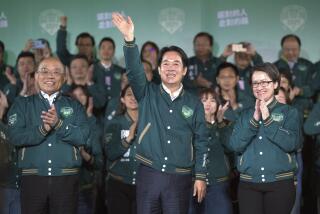Op-Ed: China’s ready for war ― against the U.S. if necessary
To mark the 90th birthday of the People’s Liberation Army on Aug. 1, China’s President Xi Jinping went to the Inner Mongolian steppe to the site where Genghis Khan began his conquest of Eurasia. There, at Zhurihe, he was welcomed by an impressive display of China’s martial might: a parade of Chinese troops, tanks, helicopters, aircraft and missiles. But the main course was a massive war game demonstrating the state of China‘s preparation to “fight and win” future military conflicts.
For what war is the PLA preparing?
Recent events should make the answer abundantly clear. In July, North Korea conducted two ICBM tests that put the American heartland within reach of its nuclear weapons. In response, the U.S. flew two B-1 bombers over the Korean peninsula to send the message, in the words of Pacific Air Forces commander Gen. Terrence J. O’Shaughnessy, that the U.S. is “ready to respond with rapid, lethal and overwhelming force at a time and place of our choosing.”
President Trump has directed his ire at China, tweeting after the North Korean missile test: “I am very disappointed in China … they do NOTHING for us with North Korea, just talk. We will no longer allow this to continue.”
If Chinese and American forces once again meet in Korea ... the PLA will not at all resemble the low-tech army of the past.
Xi’s parade, along with recent Chinese military maneuvers, sends an equally unambiguous message: If war breaks out on the Korean peninsula, China is ready to protect its national interests. A major pillar of Xi’s program for “making China great again” is building a modern military fully “capable of fighting and winning” a 21st century war ― including, if need be, against the United States.
In recent months, China has moved additional military units to its border with North Korea. It has established new fortifications and 24-hour video surveillance using aerial drones. But PLA special forces and airborne troops have begun repeatedly drilling for missions that go far beyond closing the border or establishing a buffer zone: They appear to be preparing to push deep into North Korea in the event of crisis.
Those who doubt China’s willingness to act, or its ferocity, should review what happened in 1950. That June, North Korea invaded South Korea and would have gained control of the peninsula had the American-led United Nations Command not come to the rescue. With little thought for how China ― which had barely 1/50th the GDP of the U.S. ― might react, allied forces under Gen. Douglas MacArthur pushed North Korean troops back across the 38th parallel and advanced rapidly toward the Yalu River bordering China. U.S. intelligence officers discounted the possibility that China might intervene on behalf of the North.
Nonetheless, MacArthur awoke one morning to find the vanguard of a 300,000-strong Chinese army slamming U.S. and allied forces. Caught off-guard, American units suffered severe losses. One regiment of the U.S. 1st Cavalry Division lost 600 men in close combat in a matter of hours. In the weeks that followed, what MacArthur and his fellow commanders had dismissed as a “peasant army” not only halted the U.S. advance but beat allied forces back to a stalemate at the 38th parallel.
If Chinese and American forces once again meet in Korea ― perhaps in what Gen. Raymond Thomas has warned could become a “vertical track meet” to secure the North’s nuclear weapons ― the PLA will not at all resemble the low-tech army of the past.
In 1991, Chinese leaders were stunned by the devastating effectiveness of the U.S. military during Operation Desert Storm in Iraq, when it defeated Saddam Hussein’s forces in less than a month with fewer than 150 U.S. combat deaths. Watching America’s “full-spectrum technological dominance” via space-based navigation and surveillance systems, long-range precision-guided bombs and radar-evading stealth aircraft, Chinese leaders determined to acquire the technical capabilities to counter and ultimately surpass what they referred to as “American magic.”
Accordingly, Xi has made it his mission to ruthlessly rebuild and reorganize China’s armed forces on a scale that Russia’s foremost expert on the Chinese military, Andrei Kokoshin, calls “unprecedented.” And the Pentagon is taking notice. Its annual report on the Chinese military, released in June, warned that the PLA had “modernized its conventionally armed missile force extraordinarily rapidly,” while the PLA Air Force was also “rapidly” closing the gap with the U.S.
“The world is not peaceful,” Xi said at Zhurihe, warning, “we need more than any period in history to build a strong people’s military.” Notably, the exercises there featured Chinese forces facing off against a “Blue Force” modeled on the command structure, technology, weaponry and tactics of the United States.
As Secretary of Defense James N. Mattis keeps saying, North Korea is a “clear and present” threat. Events there could drag the U.S. and China into a major war neither wants. Especially in the context of Thucydides’ Trap ― the dangerous dynamic when a rising power threatens to displace the ruling one ― once military machines are in motion, misunderstandings and miscalculations could escalate all too easily to a catastrophic conflict no one intended.
Graham Allison is a professor of government at Harvard Kennedy School’s Belfer Center for Science and International Affairs and the author of “Destined for War: Can America and China Escape Thucydides’s Trap?”
Follow the Opinion section on Twitter @latimesopinion or Facebook
ALSO
Does state funding for Medi-Cal discriminate against the Latinos it serves?
72 years after the bombing of Nagasaki, there are 15,000 nuclear weapons in the world
More to Read
A cure for the common opinion
Get thought-provoking perspectives with our weekly newsletter.
You may occasionally receive promotional content from the Los Angeles Times.





